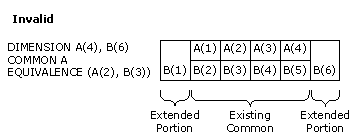Visible to Intel only — GUID: GUID-1E8543B7-B358-4F7F-8C70-15CDD5A333F4
Visible to Intel only — GUID: GUID-1E8543B7-B358-4F7F-8C70-15CDD5A333F4
EQUIVALENCE and COMMON Interaction
A common block can extend beyond its original boundaries if variables or arrays are associated with entities stored in the common block. However, a common block can only extend beyond its last element; the extended portion cannot precede the first element in the block.
Examples
The following two figures demonstrate valid and invalid extensions of the common block, respectively.


The second example is invalid because the extended portion, B(1), precedes the first element of the common block.
The following example shows a valid EQUIVALENCE statement and an invalid EQUIVALENCE statement in the context of a common block.
COMMON A, B, C DIMENSION D(3) EQUIVALENCE(B, D(1)) ! Valid, because common block is extended ! from the end. COMMON A, B, C DIMENSION D(3) EQUIVALENCE(B, D(3)) ! Invalid, because D(1) would extend common ! block to precede A's location.